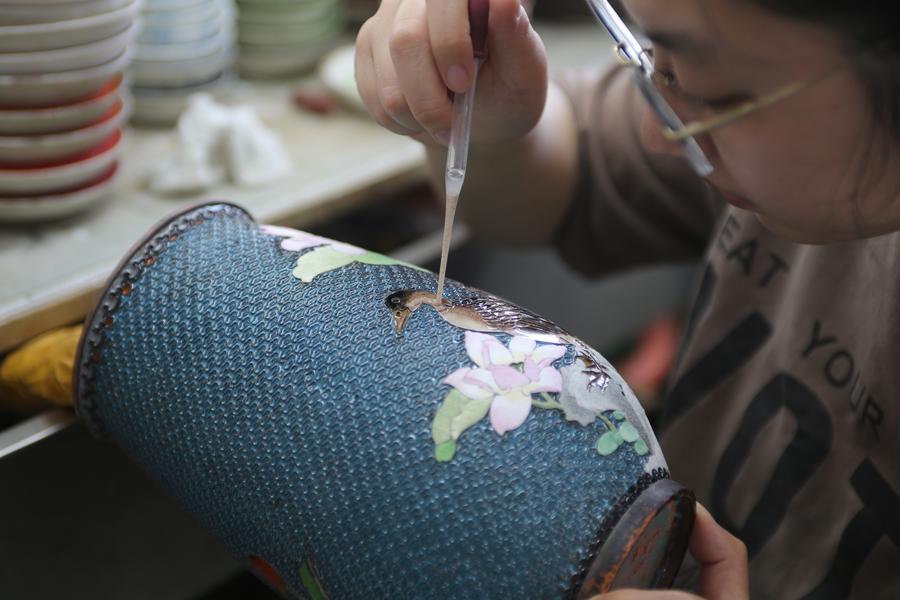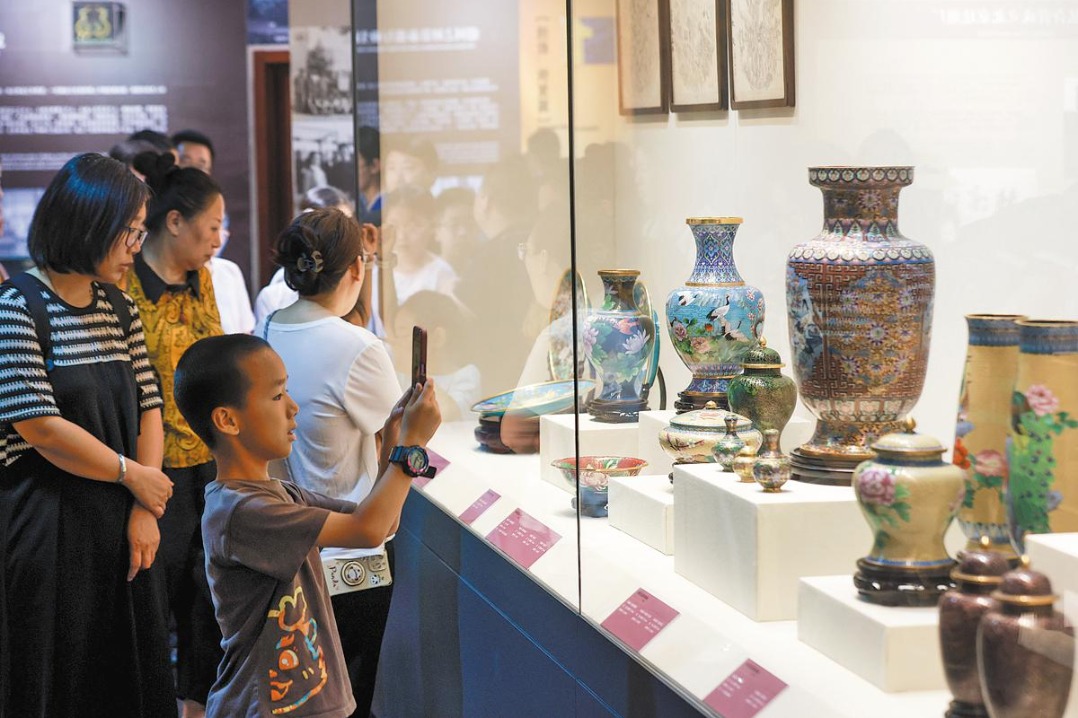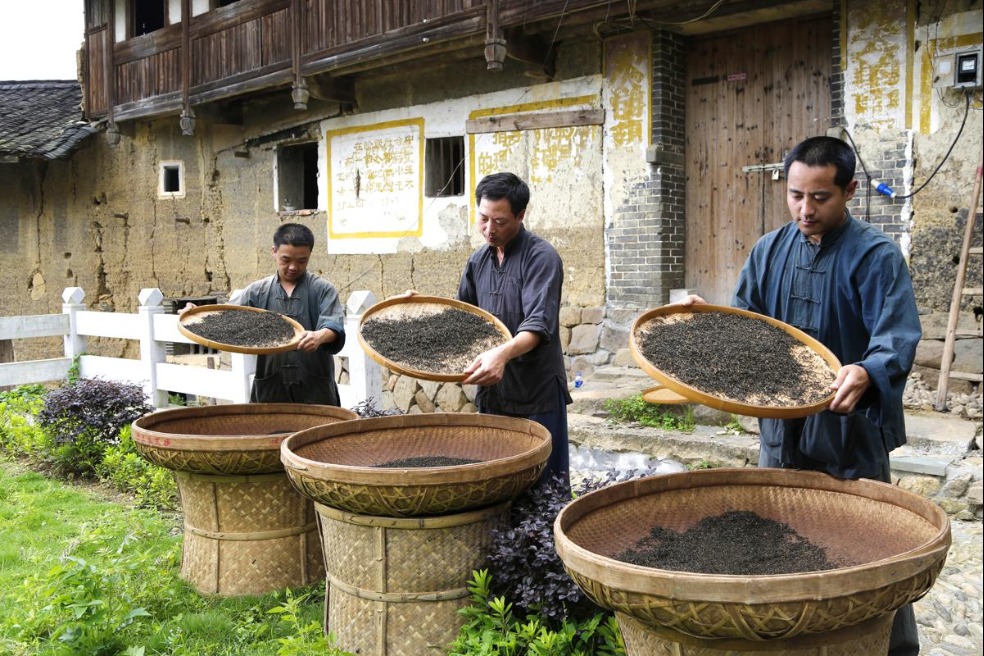Revived, traditional crafts weave modern stories


Bent over a luminous vase of pink peonies, a young craftsman guided his enameling tool in patient, practiced circles at a factory in central Beijing, breathing new life into China's cloisonne tradition.
At the Beijing Enamel Factory, cloisonne, which was more broadly used in jewelry and metalware in ancient royal courts, is now quietly created by the hands of young craftsmen.
"Cloisonne has always been about adaptation," said Zhong Liansheng, chief craft artist at the factory. Born in 1962, Zhong has watched this transformation unfold before his eyes.
Cloisonne stands out as a vivid fusion of timeless artistry and contemporary appeal, according to the master.
With ingenious designs, superb craftsmanship and auspicious symbolism, cloisonne artworks bridge tradition and modern aesthetics, gaining popularity among consumers both at home and abroad.
This growing appeal also reflects a broader revival of traditional crafts across China, backed by government support and a new generation eager to embrace their cultural heritage.
Modern craftsmanship
"At the core of cloisonne's mystique is its exquisite delicacy, achieved through countless steps that demand absolute precision at every turn," Zhong said, adding that each object — be it a gleaming dome or a small jewelry box — undergoes multiple laborious steps.
"This work is truly the perfect embodiment of craftsmanship," Zhong said. Yet for him, honoring the past is not enough.
"Don't just copy the old styles," he said, adding that these ancient arts will only endure if they find a place in people's everyday lives.
In recent years, the Beijing Enamel Factory has applied cloisonne techniques to architectural decor, from upscale interior design elements to public art installations.
"We have to create masterpieces that carry our era's aesthetics," Zhong said, highlighting the importance of keeping cloisonne alive as a dynamic art form rather than a static artifact.
His philosophy resonates with a broader shift, as across China, inheritors of intangible cultural heritage are blending tradition with modernity. One notable example is cloisonne artisan Xiong Songtao in Beijing, whose glistening enamel pieces earned his workshop a global partnership with the Spanish fashion brand LOEWE.
Similar partnerships have emerged in other crafts. The Italian brand Fendi collaborated with artisans from China's Yi ethnic group to create a baguette bag featuring traditional Yi embroidery and silverwork.
Among the driving forces of the revival of traditional crafts are young Chinese consumers. Generation Z in particular has developed a proud appetite for homegrown designs, fueling the guochao, or "China-chic" wave that values authenticity and heritage.
The surging sales of cultural-heritage-themed products reflect this trend. According to data from China's leading e-commerce platforms, Taobao and Tmall, the annual transaction volume of intangible cultural heritage-related products reached 107.32 billion yuan ($15 billion) in 2023, a year-on-year increase of 37.7 percent.
Policy-driven preservation
Behind cloisonne's comeback is not only the passion of masters like Zhong, but a concerted push by the Chinese government to preserve and revitalize traditional crafts.
Cloisonne, widely produced during the Ming (1368-1644) and Qing (1644-1911) dynasties, was listed as a national intangible heritage in 2006.
In 2017, the central government issued a set of guidelines on advancing the inheritance and development of fine traditional Chinese culture, emphasizing efforts to preserve cultural heritage, nourish artistic creation, integrate traditional culture into daily life and industry, and promote mutual learning between Chinese and foreign civilizations.
The impact of such policies is tangible. Across the country, over 11,000 intangible cultural heritage workshops have been established, preserving traditional crafts while also creating jobs in local communities. As of March this year, the number of national-level intangible cultural heritage inheritors had grown to nearly 4,000.
Zhong noted that each year, various government agencies channel resources into keeping cloisonne alive.
"The Beijing government supports us in R&D projects, including developing new enamel glazes," Zhong explained, adding that the Beijing Municipal Science and Technology Commission has sponsored the company's research into lead-free enamel, a greener alternative to traditional leaded glass glaze.
Education plays an equally vital role. The Beijing Enamel Factory has introduced cloisonne-making courses in several primary and middle schools as an extracurricular program to spark interest among youth.
"Of course, not everyone will become a cloisonne artisan," Zhong said with a smile. "But whatever they do in life, they can help pass on the flame."
Xinhua
- Revived, traditional crafts weave modern stories
- Tibetan Opera revival mesmerizes audiences in Xizang
- Xizang prefecture sees development in various aspects over the past decade
- Cloisonne shines again as old crafts regain luster
- Authorities bust ring behind bogus tips on farming
- New scam exploits child care subsidies





































